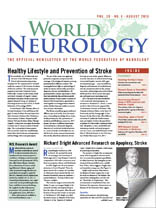
Jori Fleisher, MD
The past several decades have seen a groundswell of interest in the practice of neurology in low- and middle-income countries. As established clinicians, researchers and groups such as the World Federation of Neurology, American Academy of Neurology and the European Federation of Neurological Societies (EFNS) turn their attention to improving the care of neurology patients around the globe, tremendous opportunities for international collaborations have arisen. Even more recently, our specialty has seen a rise in individual efforts, or “bottom-up” approaches to global involvement, with the impetus frequently coming from trainees.
The unification of organizational interests with the growing demand for international opportunities by trainees could not come at a more opportune time. Currently, neurologic disorders account for more than 8.7 percent of premature deaths and years lived with disability worldwide.1 Stroke alone accounts for 4.1 percent of all disability-adjusted life years (DALYs), followed by Alzheimer’s disease and other

Sarah Wahlster, MD
dementias, epilepsy, migraine, Parkinson’s disease, CNS infections and neoplasms. Importantly, these estimates do not include traumatic brain injury, a major cause of premature death and disability particularly in rapidly developing nations. Such statistics take on even greater urgency in light of the dearth of neurologists in low- and middle-income countries. In one study, 23 African nations averaged one neurologist per 5 million population, with 12 countries having none.2
In parallel with growing epidemiologic recognition, neurologists and trainees have found more avenues for clinical involvement abroad. Numerous models exist, from brief visiting professorships, global brigades and mobile clinics to long-standing inter-institutional collaborations. Here, we briefly reflect on our experiences with several models and future directions.
Many opportunities are available at individual medical schools for students to spend a week or more abroad, shadowing in hospitals or freestanding clinics, or setting up makeshift clinics to provide acute, primary care to all comers. As a starry-eyed trainee, these rotations can be inspiring, yet raise concerns. In one author’s experiences (JF), during 10- to 14-day-long trips to Central America and Jamaica, such makeshift clinics were erected and provided care to hundreds of patients who might otherwise be untreated. In addition to such ubiquitous primary care concerns of headache and low back pain, countless individuals with intestinal parasites, malaria and other tropical diseases were treated. Such trips inevitably raise the question of sustainability, and whether we are instantiating a culture of “duffle bag medicine” that does more harm than good.3 For example, a day laborer and father of six in his early 40s presented to our Jamaican clinic with early-onset Parkinson’s disease. As a student, one’s initial thrill at recognizing clinical signs and making a diagnosis is quickly overshadowed by the knowledge that the one-month supply of carbidopa-levodopa available may only offer the patient 30 days of false hope.
Some of these shortcomings can be overcome with careful pre-trip collaboration with local practitioners. Arrangements can be made in advance for patient referrals, and the visiting clinicians can arrive with a working knowledge of local treatment patterns and availability. Short trips and pop-up clinics often spark a more deep-seeded commitment to global health that will shape participants’ careers. Furthermore, relationships formed between visiting trainees and local providers can be nurtured into fruitful partnerships in the future.
To that end, longer-term collaborative relationships have been formed, yielding additional opportunities for trainees. A key component to ensuring sustainability in these relationships is to work closely with local providers and carefully elicit their input about the needs at their institutions. These partnerships can be focused on building collaborative research projects as well as fostering a didactic exchange and improving medical education.
One example of such a formal collaboration is the Botswana-UPenn Partnership. Established as a means of building clinical and research capacity in Botswana in response to the HIV epidemic, this decade-long connection has fostered the growth of primary care residency programs in Botswana, countless research studies, and the Global Health Equities Residency Track at the University of Pennsylvania’s various residency programs.
Many opportunities are available at individual medical schools for students to spend a week or more abroad, shadowing in hospitals or freestanding clinics, or setting up makeshift clinics to provide acute, primary care to all comers.
While medical students and residents can apply to spend a single rotation in Botswana, the track provides U.S. trainees with in-depth training on the geo-socio-political context of the nation in which they will practice. Two four- to six-week-long rotations are spent on the medical wards in Botswana, providing clinical care and engaging in a scholarly pursuit. Working with partnership-affiliated attending physicians and local practitioners, trainees are incorporated into ward teams or able to provide specialty consultation services. Extended and repeated stays provide invaluable insight into the epidemiology of disease, team practices, as well as the challenges of providing the best possible care with the available diagnostic and therapeutic modalities. Neurologic in-patients tend to be plentiful, comprising about 30 percent of all medical admissions, with stroke, epilepsy, meningitis, Guillain-Barre, myelopathies and CNS complications of HIV/AIDS, among the most common chief complaints.
While rotating at a partner site, there are numerous opportunities to contribute to the medical education, clinical care and research efforts in collaboration with local providers. Such collaborations have infinite future directions. Investing in the education of trainees and students at the site is a first and crucial step to improve the care of neurological patients in a sustainable fashion. At partner sites with no local neurologist, one way to support local providers is to create a targeted curriculum, based on the most commonly seen, treatable conditions and available resources. Also, participating in teaching initiatives at the local medical school and inspiring young trainees in these areas to pursue a career in neurology can potentially improve neurological care within the country.
Research initiatives may improve diagnostic and therapeutic options in countries with limited resources. Also, scholarly pursuits can be fostered through organized mentorship as well as joint authorship of case reports and research studies. New advances in technologies also lead to a wealth of opportunities for continuous interaction and collaborative efforts between sites. The Partners Neurology Residency Program has initiated a recurring series of teleconferences with their partner sites in Uganda and Mexico, during which residents and faculty at both sites discuss interesting cases, provide neurological consultation or share didactic conferences. Another advantage of telemedicine is the potential to share neuroimaging studies, EEG data files and pathology images. While difficulties with the Internet connection in developing countries remain a major challenge for videoconferencing and the transfer of larger files, continuous communications via email and emerging technology can foster a frequent exchange between sites and perpetuate sustainable connections.
Numerous other models exist for global neurology collaborations, including Medical Education Partnership Initiatives (MEPI), NIH/Fogarty program, established visiting professor programs, AAN’s Global Health Section, and WFN’s International Working Group of Young Neurologists and Trainees. Furthermore, opportunities for participation increase as students and residents advance in their training.
The most critical step in any collaboration, however, is to ensure mutual understanding and benefit, with an eye toward building capacity for neurologic care in developing nations. Barriers to such programs include funding, limited or no pre-trip training for clinicians causing misunderstandings once in country, and poor resource sharing.
In addition to international partnerships, we recognize the tremendous potential for collaborations among globally minded neurology departments and trainees in the developed world to facilitate these exchanges, share resources and foster funding opportunities. We are currently laying the groundwork for a Neurology Global Health Consortium by uniting interested and experienced neurologists from across the U.S. By gathering the collective wisdom of individuals with experience in clinical practice, education and research abroad, we hope to learn from each other and serve as a resource for other interested trainees.
To learn more about the proposed consortium, contact Wahlster at swahlster@ partners.org. To learn more about additional opportunities, contact Fleisher at jori.fleisher@uphs.upenn.edu.
Fleisher works in the Department of Neurology at the University of Pennsylvania, and Wahlster is with the Partners Neurology Residency Program at Brigham and Women’s Hospital, Massachusetts General Hospital, Harvard Medical School.
References
1. Murray CJ, Vos T, Lozano R et al. Disability-adjusted life years (DALYs) for 291 diseases and injuries in 21 regions, 1990-2010: A systematic analysis for the global burden of disease study 2010. Lancet 2012;380(9859):2197-2223.
2. Bower JH, Zenebe G. Neurologic services in the nations of Africa. Neurology 2005;64(3):412-415.
3. Roberts M. A piece of my mind. duffle bag medicine. JAMA 2006;295(13):1491-1492.
